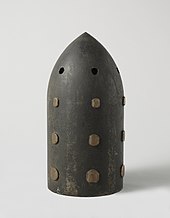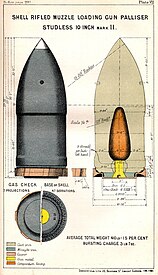197:
185:
163:
147:
250:
cavity. The powder filling was ignited by the shock of impact and hence did not require a fuze. While these
Palliser shells were effective against unhardened iron, British doctrine held that only shot (i.e. non-explosive projectiles) were suitable for penetrating the new hardened armour being developed in the 1880s; hence the gunpowder filling was discontinued.
36:
78:
249:
in the 1870s–1880s. In the shell the cavity was slightly larger than in the shot and was filled with gunpowder instead of being empty, to provide a small explosive effect after penetrating armour plating. The shell was correspondingly slightly longer than the shot to compensate for the lighter
229:
large solid projectiles without them cracking when they cooled, because the nose and base of the projectiles cooled at different rates, and in fact a larger cavity facilitated a better-quality casting. The hole at the base was threaded to accept a
217:, the head being chilled in casting to harden it, using composite moulds with a metal, water-cooled portion for the head. At times there were defects that led to cracking in the projectiles, but these were overcome with time.
115:
principle (with three rifling grooves). Palliser shot in many calibres stayed in service in the armour-piercing role until phased out of (British) service in 1909 for naval and fortress use, and 1921 for land service.
242:
had yet to be perfected. Later designs did away with the studs on the projectile body, with the gas checks being set with grooves to impart spin to the projectile.
92:
artillery projectile, intended to pierce the armour protection of warships being developed in the second half of the 19th century. It was invented by Sir
57:
44:
278:
225:
in the gun barrel. The base had a hollow pocket but was not filled with powder or explosive: the cavity was necessitated by difficulties in
231:
169:
196:
104:
Major
Palliser's shot, approved 21 October 1867, was an improvement over the ordinary elongated shot of the time.
49:
338:
184:
162:
146:
226:
222:
203:
108:
333:
282:
246:
133:, with devastating results. It was the first time that such piercing shells were used in combat.
129:
120:
124:
93:
89:
153:
327:
112:
239:
234:. This prevented propellant gases from blowing around the projectile, providing
235:
17:
214:
35:
77:
127:
fired twenty 250-pound
Palliser gunshots against the Peruvian monitor
218:
76:
221:
studs were installed into the outside of the projectile so as to
81:
Palliser shot, Mark I, for 9-inch Rifled Muzzle
Loading (RML) gun
29:
320:"Treatise on Ammunition" 4th Edition, 1887. War Office, UK
317:"Treatise on Ammunition" 2nd Edition, 1877. War Office, UK
304:"Treatise on Ammunition" 4th Edition 1887, page 237.
295:"Treatise on Ammunition" 4th Edition 1887, page 236.
27:Early British armour-piercing artillery projectile
267:Textbook of Ammunition 1936 The War Office pp 282
190:Studded Palliser shell for RML 7 inch gun, 1877
8:
60:of all important aspects of the article.
259:
107:It was adopted for the larger types of
56:Please consider expanding the lead to
7:
25:
279:"Naval Battle of Angamos Part 2"
195:
183:
161:
145:
34:
245:Britain also deployed Palliser
170:BL 12 inch naval gun Mk I - VII
48:may be too short to adequately
58:provide an accessible overview
1:
123:(8 October 1879) the Chilean
202:Studless Palliser shell for
355:
223:engage the rifling grooves
213:Palliser shot was made of
152:Studded Palliser shot for
96:, after whom it is named.
204:RML 10 inch 18 ton gun
82:
109:rifled muzzle-loading
80:
88:is an early British
111:guns rifled on the
168:Palliser shot for
83:
125:ironclad warships
121:Battle of Angamos
75:
74:
16:(Redirected from
346:
339:Artillery shells
305:
302:
296:
293:
287:
286:
281:. Archived from
275:
269:
264:
232:copper gas check
199:
187:
165:
149:
94:William Palliser
70:
67:
61:
38:
30:
21:
354:
353:
349:
348:
347:
345:
344:
343:
324:
323:
314:
309:
308:
303:
299:
294:
290:
277:
276:
272:
265:
261:
256:
211:
210:
209:
208:
207:
200:
192:
191:
188:
177:
176:
175:
174:
173:
166:
158:
157:
150:
139:
102:
90:armour-piercing
71:
65:
62:
55:
43:This article's
39:
28:
23:
22:
15:
12:
11:
5:
352:
350:
342:
341:
336:
326:
325:
322:
321:
318:
313:
310:
307:
306:
297:
288:
285:on 2002-11-26.
270:
258:
257:
255:
252:
201:
194:
193:
189:
182:
181:
180:
179:
178:
167:
160:
159:
154:RML 7 inch gun
151:
144:
143:
142:
141:
140:
138:
135:
101:
98:
73:
72:
52:the key points
42:
40:
33:
26:
24:
14:
13:
10:
9:
6:
4:
3:
2:
351:
340:
337:
335:
332:
331:
329:
319:
316:
315:
311:
301:
298:
292:
289:
284:
280:
274:
271:
268:
263:
260:
253:
251:
248:
243:
241:
237:
233:
228:
224:
220:
216:
205:
198:
186:
171:
164:
155:
148:
136:
134:
132:
131:
126:
122:
117:
114:
110:
105:
99:
97:
95:
91:
87:
86:Palliser shot
79:
69:
59:
53:
51:
46:
41:
37:
32:
31:
19:
18:Palliser shot
312:Bibliography
300:
291:
283:the original
273:
266:
262:
244:
240:driving band
212:
128:
118:
106:
103:
85:
84:
66:January 2022
63:
47:
45:lead section
334:Projectiles
328:Categories
254:References
236:obturation
215:cast iron
50:summarize
113:Woolwich
238:as the
227:casting
130:Huáscar
119:At the
100:History
247:shells
219:Bronze
206:, 1886
172:, 1886
156:, 1877
137:Design
330::
68:)
64:(
54:.
20:)
Text is available under the Creative Commons Attribution-ShareAlike License. Additional terms may apply.




